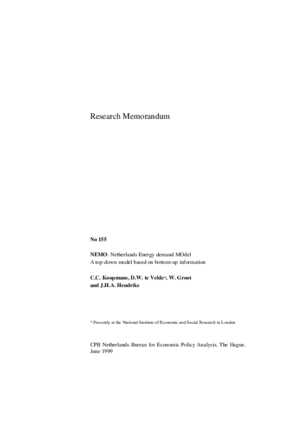NEMO: Netherlands Energy demand MOdel; a top-down model based on bottom-up information
It uses a ‘putty-semiputty' vintage production structure, in which new investments, adaptations to existing capital goods (retrofit) and ‘good-housekeeping' are discerned. Price elasticities are relatively large in the long term and small in the short term.
Most predictions of energy use are based on either econometric models or on ‘bottom-up information', i.e. disaggregated lists of technical possibilities for and costs of saving energy. Typically, one predicts more energy-efficiency improvements using bottom-up information than using econometric (‘top-down') models. We bridged this so-called ‘energy-efficiency gap' by designing our macro/meso model NEMO in such a way that we can use bottom-up (micro) information to estimate most model parameters.
In our view, reflected in NEMO, the energy-efficiency gap arises for two reasons. The first is that firms and households use a fairly high discount rate of 15% when evaluating the profitability of energy-efficiency improvements. The second is that our bottom-up information (‘ICARUS') for most economic sectors does not (as NEMO does) take account of the fact that implementation of new, energy-efficient technology in capital stock takes place only gradually.
Parameter estimates for 19 sectors point at a long-term technological energy efficiency improvement trend in Netherlands final energy use of 0.8% per year. The long-term price elasticity is estimated to be 0.29. These values are comparable to other studies based on time series data. Simulations of the effects of the oil price shocks in the seventies and the subsequent fall of oil prices show that the NEMO's price elasticities are consistent with historical data. However, the present pace at which new technologies become available (reflected in NEMO) appears to be lower than in the seventies and eighties. This suggests that it may not be adequate to extrapolate historical trends of energy efficiency improvements into the future.
We used NEMO to predict energy efficiency improvements in long-term scenario's developed by CPB in 1997. Policy simulations show that NEMO is especially suited to predict effects of energy taxes on energy use. It can also be used to assess other policies; in some cases, this requires additional assumptions. Nevertheless, NEMO offers a systematic way to analyse effects of various policies.
